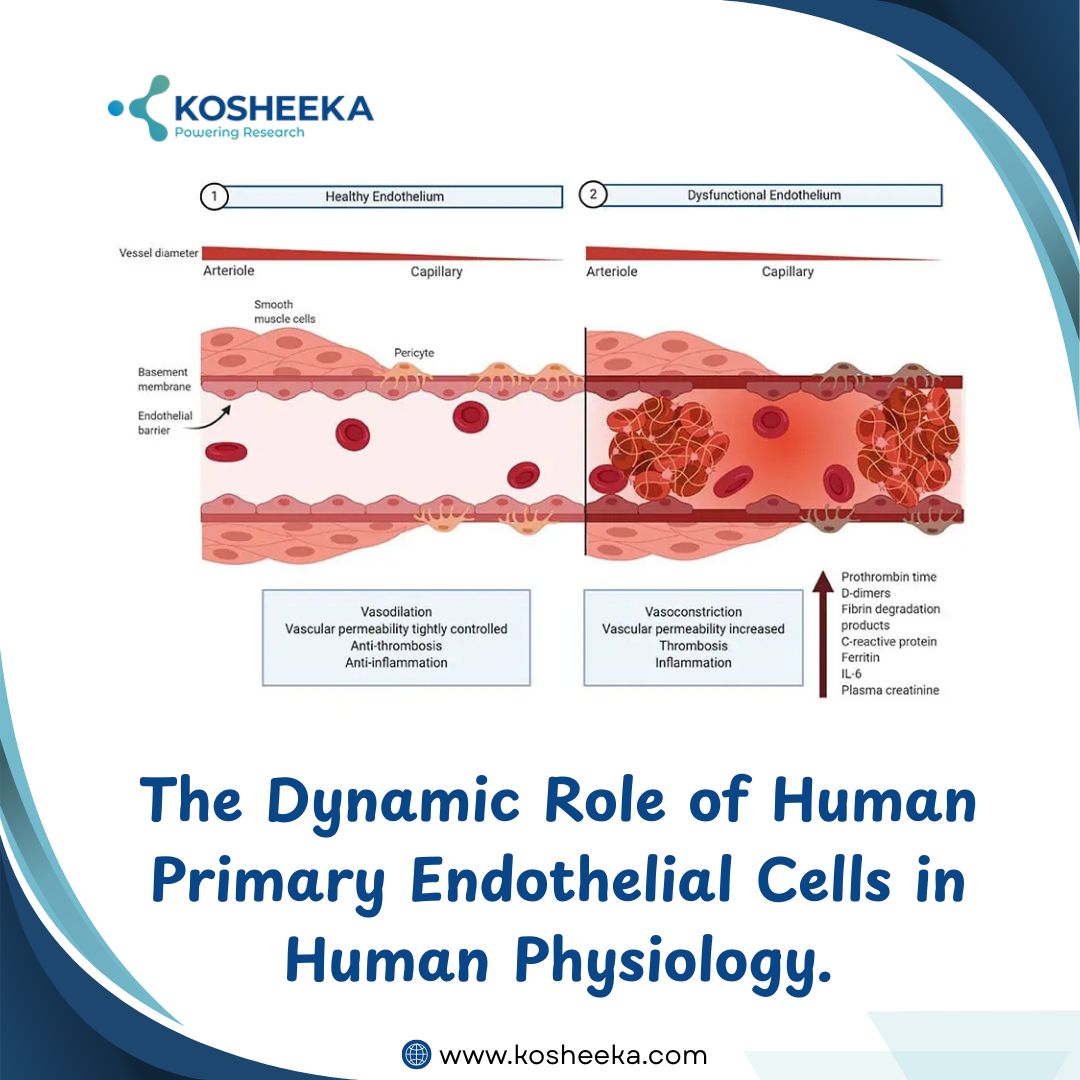Human primary endothelial cells have been employed extensively in pathophysiology and therapeutic research. These cells are the basic unit of any blood vessel—capillaries, arteries, and veins. As a core component of the circulatory system, they are integrated into each organ. Their role extends from being a mere barrier to regulating tissue homeostasis, vessel integrity, disease pathogenesis, immune modulation, etc. The significance of endothelial cells in tissues has even led to their incorporation into 3D structures.
Human Primary Endothelial Cells: In Vitro Culture
Endothelial cell culture includes primary cells and cell lines. For decades, endothelial research has mostly employed human umbilical vein endothelial cells (HUVECs). They are readily available and relatively easy to isolate. Endothelial cell lines like HMEC-1 and EA.hy926 have also gained popularity for in vitro research due to their infinite proliferation.
In the 2D culture, these cells exhibit a cobblestone morphology with characteristic surface markers vWF and CD31. Their culture might suffer from a few setbacks:
-
Low/No Adherence: Endothelial Cells can adhere to standard tissue culture flasks. However, sometimes issues with their attachment arise. It can be resolved by coating flasks with gelatin or utilizing coated flasks explicitly manufactured for these cells. Seeding higher cell density can enhance cell-cell contact, which is vital for cell adherence, survival, and growth.
-
Cell Viability: Researchers might notice low cell viability after a few passages. This could occur due to several factors, such as the medium. Typically, endothelial cell growth medium (ECGM), M199, or DMEM (with F12) are suitable choices for endothelial culture. However, the addition of growth factors like heparin and VEGF can improve cell growth.
Function
In the past, endothelial cell definition described them as the mere lining of vessels that serve as a barrier between tissue and blood. This barrier has been prominent in delivering drugs to the brain. Therefore, much research on these cells was restricted to cardiovascular and brain applications. However, growing studies have also revealed their diverse functions, shifting the perspective surrounding them.
Endothelial cells are vital for regulating the vascular tone, tightly controlling coagulation and vasodilation. They not only aid in immune cell trafficking but also mediate immune response. Their role in angiogenesis is indispensable in wound healing and tissue regeneration.
Endothelial Heterogeneity
Biomedical research also shed light on intriguing aspects of the endothelium. Endothelium varies in phenotype and genotype throughout circulation or in tissues. The presence of different types of blood vessels was known. However, the interesting fact was the different morphology and behavior of the endothelium. Endothelium contains pores or fenestrations, which add to the layer's already complex permeability. Furthermore, the absence of a basement membrane beneath the endothelium enhanced permeability, allowing cell passage. This property is more prevalent in the liver and spleen due to their functional requirements.
On diving deep, changes in the genetic profile of endothelial cells present in various tissues and during varying physiological conditions became evident. For instance, VCAM1 expression on the endothelium increases during inflammation. Such studies established that they adapt to the tissue requirements. Therefore, isolation of Endothelial Primary Cells extended to other tissues and vessel types, enabling the study of tissue-specific behavior.
Research Applications
Disease: When endothelial cells lose their ability to regulate blood flow or barrier integrity, pathologies such as hypertension, atherosclerosis, diabetes, and chronic inflammatory conditions arise. They also respond to injury, control inflammation and facilitate healing. Previously, the research concentrated on cardiovascular and neurological fields. However, it has expanded to various tissues, such as pulmonary dysfunction, visual disorders, and ischemic diseases.
Cancer: Disrupted vessel integrity grants high permeability to tumor vasculature. Scientists have exploited this feature to develop nanomedicine with higher chances of biodistribution to tumors. This minimizes harm to other normal tissues. These nanomedicines include angiogenic drugs that target the tumor vessels and halt their growth.
Tissue Engineering: The beginning of 3D culture utilized cells from corresponding organs. However, the growing importance of the endothelium led to its inclusion in co-culture and 3D models. The functioning and survival of these constructs improved, raising the use of these cells.
Angiogenesis: Many disorders occur due to endothelium dysfunction, such as stroke, limb ischemia, liver disorders, etc. The repair and formation of vessels follows the process of angiogenesis. Therefore, scientists are also focusing on this process to formulate novel therapies.
In Conclusion
Human Primary Endothelial Cells have become a focal point of research to understand vascular biology, inflammation, disease mechanisms, and vessel repair. Several anti-angiogenic medications and vasodilators are already available in the market for the treatment of various disorders. The heterogeneity of the endothelium alludes to its crucial role in tissue and vessel functioning. It resulted in their incorporation into a 3D model to improve cell survival and function. Kosheeka has realized their substantial contribution to research and provides assured quality endothelial primary cells. Its team characterizes and tests them robustly to elevate drug discovery and development.



